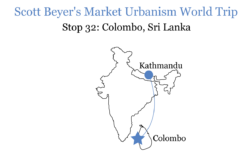Debt Diplomacy: China’s Third World Play
While the U.S. pursues neoconservatism, China is doing nation-building across the Global South.
When visiting Addis Ababa, Ethiopia—where a humanitarian crisis caused by civil conflict was visible on the streets—I got to see firsthand the difference between U.S. and Chinese diplomacy. I saw a common political insignia on bumper stickers and tote bags— #nomore—that protested America’s role in funding a murderous insurrectionist group within the conflict. Meanwhile, the name of Chinese state companies could be found on glistening new office towers and parks. It spoke to the different diplomacy strategies of both countries. China’s is premised on nation-building, followed by debt dependence for the “beneficiary” country.
After several decades of massive growth following economic liberalization, China has used its newfound wealth to build a large sphere of influence. Since 2013, reports The New York Times, China’s Belt and Road Initiative has lent nearly $1 trillion to infrastructure projects worldwide. Whether it’s highways, railroads, hospitals and more, I’ve seen numerous projects during my 1.5-year Global South tour. But the investments come with massive debt for developing economies, and the possibility that China will confiscate and use these holdings for military expansion.
The investments must be viewed in a broad geopolitical context. The Chinese Communist Party wants the country to become a global power, and works with governments shunned by the West. The Belt and Road Initiative grew out of a theory which, the Times writes, “contended that China should pay less attention to confronting powerful allies of the United States…and focus more on Central Asia and the Middle East.”
In Latin America, China invested over $130 billion in mining, infrastructure, and energy. Venezuela and Argentina have been among the largest recipients. According to Oxford University, “China has become Africa’s biggest bilateral lender, holding over $73 billion of Africa’s debt in 2020 and almost $9 billion of private debt.” In Southeast Asia, China has leveraged Laos’ debt to bolster its regional ambitions: there, much of its $12.2 billion investment went to a railroad planned to extend into other Southeast Asian countries. Chinese tourism to Laos has increased, and the Yuan is commonly used.
The investments have gone beyond developing countries, into European logistics: China majority-owns Greece’s largest port, and has a share in Germany’s Hamburg port.
The developing world indeed has real infrastructure needs—many of the utilities we Americans take for granted don’t exist there. But debt to China is a risky path, as an example from Sri Lanka shows. The country owes $34.8 billion in foreign debt, of which 45% is due to China. Sri Lanka defaulted on these loans in 2022, leading to an economic crisis.

Some of China’s Sri Lankan loans proceeded despite questions of feasibility. The Hambantota International Port expansion was first pitched to American and Indian investors, who rejected it due to concerns about Sri Lanka’s economy. After the default, port management was leased on favorable terms to the Chinese. Chinese companies are also building Port City Colombo, an upscale mixed-use development, within the port and near the city’s premier business district. The port is enjoying other new investments, such as an elevated highway.
The debt crisis comes at great cost to Sri Lankan society. Following the default, half a million jobs were lost and inflation rose by over 50%.
“The rest of the country is facing higher taxes to deal with the economic crisis,” academic Priyangi Jayasinghe told al-Jazeera in reference to Port City Colombo.
The problem goes beyond Sri Lanka. Various recipients of Chinese loans devote large chunks of government revenue to paying off this debt. Pakistan couldn’t afford to keep generating electricity at the needed rate, causing industrial shutdowns and mass job losses. Laos is likewise struggling to repay its debts—the billions it borrowed from China to fund dams, trains and highways have drained its foreign currency reserves. Zambia defaulted on $42.5 million in debt.
Chinese lending programs accept resources as collateral for loans, such as oil. This is how China financed the construction of infrastructure and “new towns” in Angola.
Domestically, China has been dealing with its own debt, which stands at $14.3 trillion—perhaps explaining why this foreign lending spree has declined recently. This raises questions about whether a cash-strapped China will look to recoup some of their investment sooner to pay down their own debt.
Overall, what China is doing seems smart—as foreign policy strategies go. The fiscal problems of Third World countries are of their own making, and China is taking advantage of this by collecting interest and choosing key assets as collateral. Sovereign debt is among the most pernicious threats to the long-term prosperity of the developed and developing world alike, but at least one country is benefiting from it in a way that ultimately leads to more economic development. If the U.S. is smart, it will steer its own foreign policy in this direction, and away from funding conflicts.
Cover image use authorized under the Creative Commons Attribution 2.0 Generic license.
Graphic Credit: The Market Urbanist.
Catalyst articles by Scott Beyer | Full Biography and Publications
